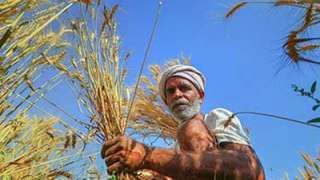MEDIA
Farm sector doles: Band-aid solutions hide jobless growth; India's agrarian economy needs liberalisation, not govt handouts
www.firstpost.com | February 25, 2019
The Interim Budget this year announced a bonanza for small and marginal farmers, promising them income support of Rs 6,000 per year. The ruling government claims that it will benefit 12 crore farmers holding cultivable land up to two hectares. Opposition and the media critiqued the income support initiative as a move to woo farmers ahead of the upcoming elections when they are facing one of the worst agrarian crisis in recent times.
Just a day before the election budget there was a news report, quoting periodic labour force survey (PLFS) data (not officially released), that India’s unemployment rate in 2017-18 was at a 45-year high at 6.1 percent.
Joblessness in rural areas has compounded the agrarian crisis. Unemployment among rural male youth, aged 15 to 29, rose from 5 percent to 17.4 percent between 2011-12 and 2017-18. For rural women in the same age group, unemployment rose 4.8 percent to 13.6 percent. Critics have pointed out that the government's farm income scheme (Pradhan Mantri Kisan Samman Nidhi) is too little to have any sizable impact on farmers let alone alleviate their distress.
In spite of its huge budgetary allocation Rs 75,000 crore per year, which exceeds National Rural Employment Guarantee Scheme (NREGS) budget, it offers very little purchasing capacity to individuals, let alone potential to create sizable jobs. In the debate on income versus jobs, this report reveals that people prefer jobs to governments charity income schemes.
Instead of addressing the dwindling jobs and agrarian crisis, the government has responded by announcing a Targeted Basic Income (TBI) scheme for farmers. The ‘Pradhan Mantri Kisan Samman Nidhi’ is a scaled down version of Quasi Universal Basic Rural Income (QUBRI) proposed by Arvind Subramanyam and colleagues. It is in line with NITI Aayog, and economists, especially western scholars writing on India, advocating Universal Basic Income (UBI) as a silver bullet for poverty reduction, by replacing various subsidies the government provides.
For TBI schemes to have any tangible effect on reducing poverty, it has to cover the basic expenditure of the household for survival. If the government decides to offer half the minimum wage Rs 160 per day to each household, the total expenditure would cost Rs 2,88,000 crore, which is more than the total subsidy bill of the Union government in 2018-19.
To finance this the government will have to roll back the entire ecosystem of subsidy schemes on food, fuel, fertilizer, health, and education. This will impose unprecedented social and human costs, akin to demonetisation, affecting food security, nutrition, education, and health of the vulnerable population. It is also politically unviable as welfare schemes once introduced in India are here to stay for eternity, in different forms.
Targeted income support based on land size poses a huge challenge of exclusion of small and marginal farmers, who account for more than half of the total land holdings and may not hold formal land titles. The scheme also excludes a sizable number of landless contract farm labourers.
Analysis by PRS India on Land records and Titles in India shows that the Land Records Modernisation Programme which aims to give conclusive land titling is far from complete. As of September 2017, 86 percent of the digitisation of records have been completed mostly based on the surveys done in the colonial era, carrying the legacy of the zamindari system.
Only 47 percent of the mutation records (recording the transfer of ownership) have been computerised, out of which only 39 percent of the spatial data has been verified. Chances are that a farmer identified by the records for income transfer may be a long-dead grandfather of the living farmer.
By choosing TBI scheme like farm income transfer, the government is choosing a path of least resistance, without acknowledging its failure to generate jobs. An unfortunate outcome of this may be forgetting the lessons learned over the centuries for poverty reduction through productive employment generation.
To handle the agrarian crisis, India’s farm economy needs liberalisation, not government handouts- which at best can act as band-aid solutions. Eliminate the perpetual dependence of farmers on government and bring them closer to market. Unlike TBI, NREGS is a demand-driven scheme, where beneficiaries are self-selected. NREGS has been criticised for not providing productive employment, not generating substantive assets, and for failing to develop marketable skills. Shift NREGS focus on skilled employment so that their perpetual dependence on employment guarantee schemes subsides.
Invest in human capabilities through education, universal health care, and skill development. Focus on universalising secondary education and expanding vocational education. India faces a double burden of malnutrition- both undernutrition and obesity which impacts the productivity of the labour force. Develop skills - both soft and hard - to prepare the bulging young population for new generation jobs.
Move away from the metro-centric development model, to the creation of economic hubs in Tier II and Tier III cities. Diversify economy at the local level, keeping the demographic profile and geographic advantages into account.
We need writers, journalists, teachers, data analysts, managers, and entrepreneurs, as much as shopkeepers, truck drivers, and food vendors in small cities and towns. Empower women to break the social barriers to enter traditionally male-dominated sectors like hospitality, transport, and industries. Distributed and diversified economy focusing on district and tehsil development generates greater employment and return on investment than the unitary mega city models. The USA, with 1/4th of India’s population and 3 times area, has far more economic clusters, spread over length and breadth of the country, than India.
While enhancing human capabilities, addressing regional inequalities, rejuvenating local economies, and diversification of economy may look challenging- but it is the only way out to address the challenges in employment and economic growth in the long run.
- Prof. Shivakumar Jolad, Associate Professor, Public Policy

